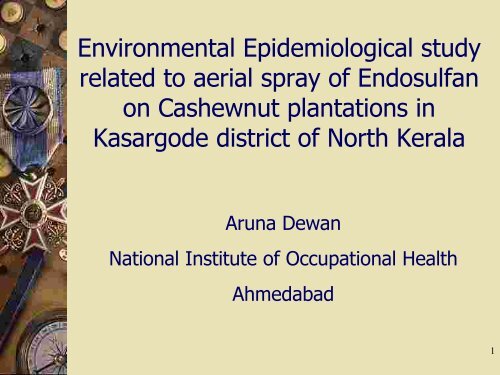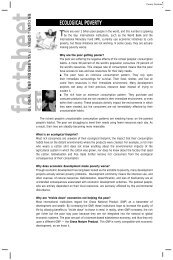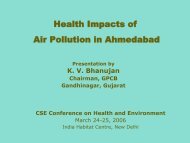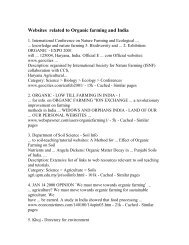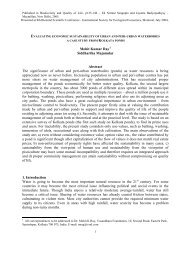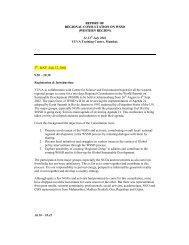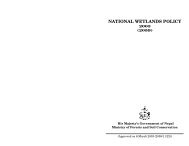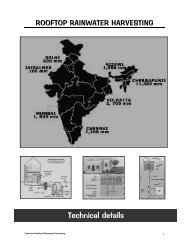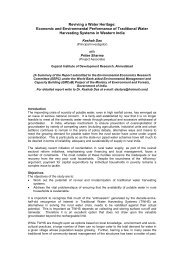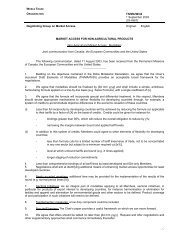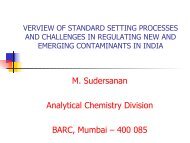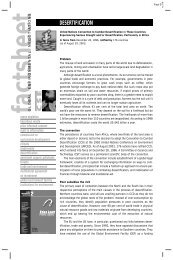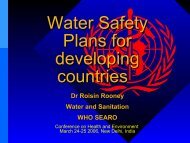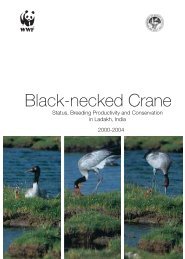Control Group - Rainwater Harvesting
Control Group - Rainwater Harvesting
Control Group - Rainwater Harvesting
You also want an ePaper? Increase the reach of your titles
YUMPU automatically turns print PDFs into web optimized ePapers that Google loves.
How was the problem recognized?•Since Feb. 2001, a number of reports appeared innational dailies , popular magazines and TV channelsregarding health problems being linked to aerial spray ofEndosulfan, in Kasargode district of Kerala.• This pesticide had been sprayed twice a year for morethan twenty years to control the tea mosquito on cashewnut plantations located in the area.• A wide range of illnesses such as neurologicaldisorders, congenital malformations, allergies,reproductive disorders and cancers were reported.•The National Human Rights Commission initiated suomoto action and asked a number of agencies includingICMR to investigate the matter and submit a report.2
List of confirmed cases of various diseases reportedby Dr. Y.S. Mohankumar from Padre village.DiseaseNo. of CasesCancer 49Mental retardation 23Congenital anomalies 9Psychiatric cases 43Epilepsy 23Suicide 9Total* 156Total (by January 26)** 197NOTE: * - cases counted by January 5, 2001** - break-up not available3
Geographic location of the areaHome5
CashewPlantationsPlantation is at the top and people live in the valley8
Important points considered at thetime of designing the study In the case series reported byDr. Mohan Kumar, there was nodenominator The types of diseases reported are notunusual and could be due to othercauses The houses were scattered and detailedhouse to house survey was very difficult12
Probability of endosulfan exposures It is very difficult to associate chronichealth effects with pesticide exposuresbecause most of the times there aremixed exposures.This was a uniquesituation because only one pesticide –Endosulfan had been sprayed for morethan twenty years. The topography of the area was peculiarwith plantations on hill tops andresidential areas in the valley13
Probability of endosulfan exposures Endosulfan is known to bind to soilparticles.The area has a rainfall of 140inches per annum and run off water islikely to carry the soil sediments into thevalley. People living in valley use water fromstreams which originate from theplantations There is no source of water supply otherthan Surangas, wells or streams Maximum number of diseases werebeing reported from people living near a14
Suranga, apeculiar sourceOf water supplyfor peopleLiving in the valley15
Environmental Epidemiological Study was undertakenwith the followingObjectives:1.To confirm the reported disease pattern in theexposed populations and evaluate the magnitudeof the problem by comparison with controlpopulations through a well designedepidemiological study.2. To search for etiological factors if the exposedpopulations show abnormal disease patterns andgenerate a hypothesis.3. To analyse endosulfan residues in environmentaland biological samples.16
Methodology and plan of work:After preliminary visits it was decided to select schoolchildren for the study17
Material and Methods:Exposed <strong>Group</strong>: School childrenof a village near cashew plantationswhere endosulfan was sprayedfor over 20 years. (619 children).<strong>Control</strong> <strong>Group</strong>: Children of asimilar school of a villageabout 20 KM away whereendosulfan has beennever sprayed. (416 children)18
Why children were selected as theexposed population Many of the diseases reported were inthe children such as epilepsy, cerebralpalsy, congenital malformations etc. Due to high literacy, most of the childrenattended school and school records werewell maintained It was possible to get full cooperationfrom schools through district healthauthorities19
Why children were selected as theexposed population Parents were asked to accompany thechildren and family details could berecorded at the same time It was possible to get informationabout siblings who were not able toattend the school due to physical ofmental health problems20
Selection of control groupOur major criteria for the selection ofcontrol population was the similarity inethnic background, climate, food habits,occupations, crops and socio-economicstatus and absence of aerial spray ofendosulfan.21
Parameters selected for the studyParameters of exposure and effectwere selected after detaileddiscussions with members of the SACand the Dept of Pediatrics, KMC,Mangalore, literature survey for toxicityof endosulfan and availability ofstandard techniques.22
Study ParametersQuestionnairePhysical Examination by a Pediatrician.Sexual Maturity Rating (Tanner’sClassification) by Pediatrician.Blood Samples Analysed for:Endosulfan residues.Hormonal Analysis:Thyroid Hormones: T3, T4 and TSHSex Hormones: Testoterone, Oestradiol,Progestrone, FSH, LH, Prolactin andgrowth hormone.Cytogenetic Studies23
Questionnaire and medical examinationIn childrenThe questionnaire included details ofbirth history and other factors whichcould have caused the illnessesbesides those which could be due toendosulfan toxicityThe pediatricians were requested to givea definite diagnosis wherever possibleAny case showing an abnormality wasreexamined by a senior pediatrician24
Family QuestionnaireIllnesses and deaths in the family wereenquired from the parentsParents were requested to bring anyrelevant papers related to illness in thefamily members e.g. reports ofinvestigations, medicine strips etcDetails of cattle owned and any illnesseswere also recordedSource of water, food habits,occupation, use any herbal remedieswere recorded25
Investigations (contd..)Satellite based assessment ofphysiographic disposition of villages inthe cashew plantation area ofKasargod district: The RegionalRemote Sensing Service Centre(RRSSC), BangaloreEstimation of Endosulfan residues inenvironmental samples.27
Some precautions taken during the study The field study was carried out in onestretch over a period of 20 days The questionnaires were completed byqualified social scientist conversant with thelocal languages Exact date of birth of each child waschecked from the school records Same pediatricians did the examination ofthe study and control groups Same instruments were used ( weighingmachine, skin calipers etc.)29
Some precautions taken during the study Methodologies for estimation of endosulfanresidues and serum hormone levels werewell standardized at NIOH and analysis wascarried out by trained persons The completed questionnaires were checkedeveryday by one senior team member whowas present in the field all the time30
ResultsThe exposed and study group childrenwere similar when compared byanthropometric parameters, parentsoccupations, ethnicity and food habitsPrevalence of bronchial asthma, allergicskin disorders was similar in both groups( not high as reported by media)Chromosomal aberrations did not showany difference between the two groupsCancer cases reported by Dr. MK couldnot be confirmed31
Results (contd.)There was significantly higherprevalence of neurobehaviouraldisorders, congenital malformations infemale subjects and abnormalitiesrelated to male reproductive system inthe study group childrenSerum endosulfan residue levels weresignificantly higher in study populationas compared to the control groupshowing that the study population hadmuch higher exposure than referencepopulation.32
Mean ± SEM levels (ppb) of SerumEndosulfan in study and control subjects<strong>Control</strong>(n=45)Study(n=70)α-Endosulfan 0.87 ± 0.23 4.24 ± 0.74**β-Endosulfan 0.40 ± 0.17 1.77 ± 0.36**Endosulfan 0.10 ± 0.08 1.47 ± 0.33**SulfateTotal Endosulfan 1.37 ± 0.40 7.47± 1.19**** p < 0.00133
Prevalence of scholastic backwardness (learningdisability) as reported by the class teacher andthe results of annual examinations.ParameterExposed(619)<strong>Control</strong>(416)StatisticalSignificanceLearningdisability66(10.7%)11(2.60%)P
IQ evaluation by “Draw A Man Test”in Exposed and control population.IQrange<strong>Control</strong>ExposedSignificance
Comparison of male children participating in theSMR studyParameters <strong>Control</strong> (n=90) Study(n=117)Age (years) 13.10 ± 2.12 12.80 ± 2.07Height (cms) 141 ± 10.60 139 ± 13.30Weight (kg) 30.70 ± 7.44 29.50 ± 8.93BMI 15.30 ± 1.98 15.00 ± 2.11Skin fold 7.31 ± 2.15 7.40 ± 2.28thickness (mm)36
4Serum LH levels IU/L321StudyRsq = 0.5150<strong>Control</strong>08101214161820Rsq = 0.1826Age (years)37
10Serum Testosterone Levels (ng/mL)8642StudyRsq = 0.5163<strong>Control</strong>0Rsq = 0.46268101214161820Age in years38
5SMR Score for Pubic Hair432StudyRsq = 0.4358<strong>Control</strong>1Rsq = 0.48158101214161820Age in years39
5SMR Score for Testes432StudyRsq = 0.3611<strong>Control</strong>1Rsq = 0.47868101214161820Age in years40
5SMR Score for Penis Development432StudyRsq = 0.3631<strong>Control</strong>1Rsq = 0.4520810121416182041
Prevalence of Congenital Abnormalitiesin Male <strong>Control</strong> and Exposed SubjectsAbnormalityCongenital HydroceleUndescended TestesCongenital Inguinal HerniaCerebral PalsyMacrocaphelyCongenital heart diseaseCongenital skeletal disorderCongenital Cataract/ retinopathyTotal Cases<strong>Control</strong>(n=233)0 ( 0.00)0 ( 0.00)1 ( 0.43)0 (0.00)1 (0.43)4 ( 1.72)1 ( 0.43)1 ( 0.43)8 (3.43 )Exposed(n=361)4 ( 1.11)2 ( 0.55)1 ( 0.28)1 ( 0.28)0 (0.00)2 ( 0.55)3 ( 0.83)3 ( 0.83)14 (3.88)RR (95% CI)1.43 (0.48 – 2.65 ) NS.
Illnesses in the families Our data does not support higherprevalence of bronchial asthma, skinproblems and suicides in the exposedpopulation Cancer cases reported by Dr. MohanKumar could not be confirmed There was a significantly higherprevalence of convulsive disorders in theexposed group families43
Conclusions1. There is a close similarity between thespectrum of health effects observed in thestudy population and those described inanimal experiments. This supports thehypothesis of endosulfan as a causativefactor for the endpoints observed in thestudy.3. The physiography of Padre village hadbeen a major factor responsible forcontinued exposure of the population.44
4. It was found that the two groups differedmainly with respect to aerial spray ofendosulfan. Therefore the most probablecause for the health problems in the studyarea could be relatively high and continuedexposures to endosulfan through variousenvironmental media such as food, water,soil and air.5. The detection of endosulfan residues in thereference area does not antagonize ourhypothesis and in fact this may havemasking effect on the observed healtheffects.45
Limitations of the SMR study(3)Non participation in SMR study - 57% ofthe exposed and 33% of the controlparticipants did not agree for SMRexamination. However, growth relatedend points (height, weight and skin foldthickness) were comparable amongstthe non participating groups.(4) One time collection of blood samplesfor hormone analysis - The sexhormone secretion is pulsatile in naturewith lot of diurnal variation.46
Difficulties Deadlines set by NHRC First report had to be submitted in Jan.2002 and final report by July 2002. Pressure by Pesticide Industry Controversies created by Expert groupset up by Ministry of Agriculture Contradictory reports submitted by KAUand FIPPAT47
Participating scientists Principal Investigator,Dr. H.N. Saiyed, Director Co-Investigator,Dr.(Mrs.)A.Dewan, Dy. Director(S.G.) Analytical Work Dr. T.S. Patel, Dy. Director Dr. V.K. Bhatnagar, S.R.O. Dr. Rekha Kashyap, S.R.O. Dr. V. Krishnamurthy48
Analytical WorkDr. S.N. Sinha, R.O.Mr. M.R. Varia, R.A.Mr. N.M. Desai, R.A.Mr. M. M. Mansoori, Lab. Asst.Cytogenetic Assay,Mr. B.C.Lakkad, ADMr. A.M. Suthar, T.O.Mr. M.M. Patel, R.A.Mr. A.K. Gautam, R.A.49
Hormone AssayDr. K. G. Patel.Dr. S.S.A. Zaidi, Asst. DirectorMrs. S.J. Gandhi, T.O.Statistical Analysis: Mr. P.K.Kulkarni,DDParticipating staff from ROHC (Bangalore)Dr. H.R. Rajmohan, Dy. DirectorMr. B.K. Rajan, Asst. DirectorMrs. Lalitha Nagaraj, R.A.50
Participating staff from Department ofPediatrics, Kasturba Medical College, Mangalore.Prof. U.V. ShenoyDr.Rathika D. ShenoyDr.RoshanAnnOommenDr.Sangeetha MaheshDr. VasanthDr. Prathiba KamathDr. Siddharthan S.Dr.E.VenkatakamalakarRaoDr.DuggabattiAnjaneya Prasad51
Participating staff from Department ofPediatrics, Kasturba Medical College, Mangalore.Dr. Habib Alam RazaDr. Bodla Hari PrasadDr. Syed Mohamed OmranDr.Venkatagiri Praveen KumarDr.Podalakur Madhusudhan RaoDr. Venkata RavanammaDr.VadlamudiRadha MadhaviDr. Maya Menon52
Publications Report to NHRC ( July, 2002) Publication of Endosulfan Study Effect of Endosulfan on MaleReproductive DevelopmentH N Saiyed, Aruna Dewan, V KBhatnagar, U Shenoy, R Shenoy, HRajmohan, Kumud Patel, RekhaKashyap, P K Kulkarni, B Rajan and B CLakkad Environmental HealthPerspectives 111 (16), 2003; 1958-196253
Commenting on the study, Dr. Jim Burkhart,science editor for EHP, says,"This is the first human study to ever measurethe effects of endosulfan on the malereproductive system. Decades of spraying thispesticide,and only this pesticide, on the villageprovided a unique opportunity to analyze itsimpact. Although the sample size is somewhatlimited, the results are quite compelling."54


